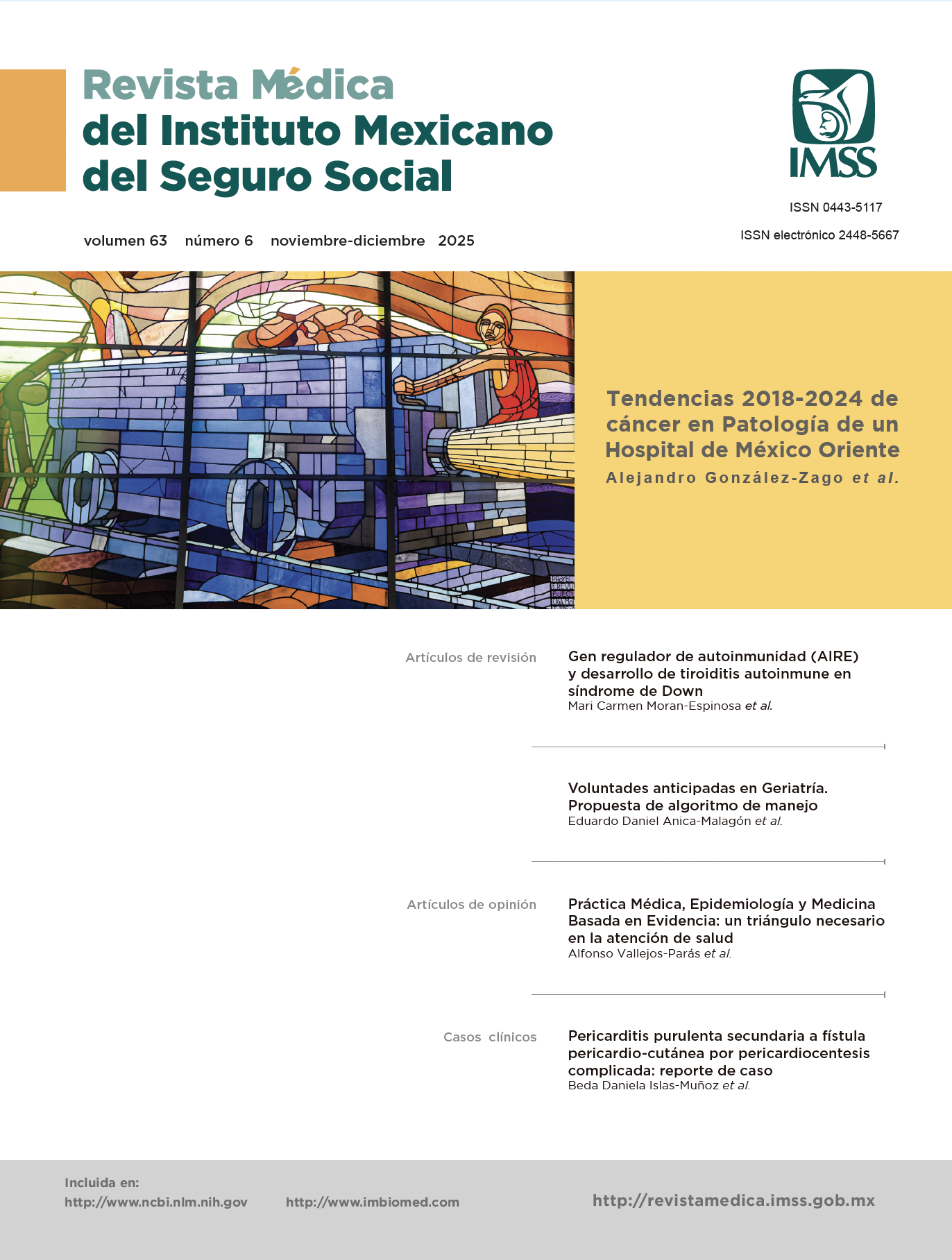Medical Practice, Epidemiology, and Evidence-Based Medicine: A necessary triangle in healthcare
Main Article Content
Keywords
General Practice, Epidemiology, Evidence-Based Medicine, Health Care, Quality of Care
Abstract
Today's healthcare faces complex challenges that require a comprehensive approach based on the best available evidence. Evidence-based medicine has influenced modern medicine and has been adopted as an element of scientific rigor. Meanwhile, medical practice, which has been based on theoretical reasoning, favouring the observation of patients without systematizing clinical experience, has shaped modern clinical practice with a relationship with research and epidemiology. It has contributed to the characterization of diseases and guidelines for their prevention and control. The combination of medical practice, epidemiology, and evidence-based medicine not only improves the quality of care but also optimizes clinical decision-making and strengthens public health policies. However, in daily practice, these areas are not always effectively integrated. This article addresses the need to consolidate this fundamental triangle to improve medical and public health care, with the challenging integration of information technologies.
References
1. Smith R. The future of the medical profession: reaffirming our professionalism. Lancet. 2018;351(9106):1381-2.
2. Cabana MD, Rand CS, Powe NR, et al. Why don't physicians follow clinical practice guidelines? A framework for improvement. JAMA. 1999;282(15):1458-65.
3. Field MJ, Lohr KN, editors. Clinical practice guidelines: directions for a new program. National Academy Press; 1990.
4. Frérot M, Lefebvre A, Aho S, Callier P, Astruc K, Aho Gle´le´ LS (2018) What is epidemiology? Changing definitions of epidemiology 1978-2017. PLoS ONE 13(12):e0208442. https://doi.org/10.1371/journal.pone.0208442
5. Evans AS. Re: Definitions of epidemiology. Am J Epidemiol. 1979; 109(3):379–82.
6. Lilienfeld DE. Definitions of epidemiology. Am J Epidemiol. 1978; 107(2):87–90.
7. Rothman KJ. Epidemiology: An Introduction: OUP USA; 2012 2012/06/21/. 281 p.
8. Gerstman BB. Epidemiology Kept Simple: An Introduction to Classic and Modern Epidemiology, Second Edition. 2 edition ed. Hoboken, N.J: Wiley-Liss; 2003 2003/09/04/. 436 p.
9. Lugtenberg M, Burgers JS, Westert GP. Effects of evidence-based clinical practice guidelines on quality of care: a systematic review. Qual Saf Health Care. 2009;18(5):385-92.
10. Salathé M, Bengtsson L, Bodnar TJ, Brewer DD, Brownstein JS, Buckee C, et al. Digital Epidemiology. PLOS Computational Biology. 2012; 8(7):e1002616. https://doi.org/10.1371/journal.pcbi.1002616
11. Salathé M. Digital epidemiology: what is it, and where is it going? Life Sci Soc Policy. 2018; 14. https://doi.org/10.1186/s40504-017-0065-7
12. Gordis L. Epidemiology. 5th ed. Elsevier Health Sciences; 2019.
13. Informe de la Comisión Independiente de Investigación sobre la pandemia de COVID-19 en México. Aprender para no repetir. México, 2024. Disponible en: https://www.comecso.com/publicaciones/informe-sobre-la-pandemia-de-covid-19-en-mexico
14. Bonita R, Beaglehole R, Kjellström T. Basic epidemiology. World Health Organization; 1993.
15. Ioannidis JPA, Cripps S, Tanner MA. Forecasting for COVID-19 has failed. Int J Forecast. 2020;36(3):663-4.
16. Green MS, Nitzan D, Schwartz N, et al. Ethical issues in epidemiological research and public health practice during a pandemic. J Clin Epidemiol. 2020;124:186-90.
17. Sackett DL, Rosenberg WM, Gray JA, Haynes RB, Richardson WS. Evidence-based medicine: what it is and what it isn't. BMJ. 1996;312(7023):71-2.
18. National Institutes of Health (NIH). What is Precision Medicine? Disponible en: https://ghr.nlm.nih.gov/primer/precisionmedicine/definition
19. Straus SE, Glasziou P, Richardson WS, Haynes RB. Evidence-based medicine: how to practice and teach EBM. 5th ed. Elsevier Health Sciences; 2018.
20. Djulbegovic B, Guyatt GH. Progress in evidence-based medicine: a quarter century on. Lancet. 2017;390(10092):415-23.
21. Greenhalgh T. How to read a paper: the basics of evidence-based medicine. 6th ed. BMJ Books; 2014.
22. Organización Panamericana de la Salud. Síntesis de la evidencia y recomendaciones de la OPS/OMS. Disponible en: https://journal.paho.org/es/numeros-especiales/sintesis-evidencia-recomendaciones-opsoms
23. Kriegeskorte N, Golan T. Neural network models and deep learning. Curr Biol. 2019 Apr 1;29(7):R231-R236. doi: 10.1016/j.cub.2019.02.034.
24. Ramesh AN, Kambhampati C, Monson JR, Drew PJ. Artificial intelligence in medicine. Ann R Coll Surg Engl. 2004 Sep;86(5):334-8. doi: 10.1308/147870804290.
25. Bini SA. Artificial Intelligence, Machine Learning, Deep Learning, and Cognitive Computing: What Do These Terms Mean and How Will They Impact Health Care? J Arthroplasty. 2018 Aug;33(8):2358-2361. doi: 10.1016/j.arth.2018.02.067. Epub 2018 Feb 27.
26. Medina Fuentes EA, Ruíz Valdez CA, Hernández Bautista PF, Cabrera Gaytán DA, Olivas Fabela GM, Mireles Garza JA, et al. Effectiveness of physician-based diagnosis versus diagnostic artificial intelligence algorithms in detecting communicable febrile diseases in Mexico. Digit Health. 2025 Jun 30;11:20552076251353292. doi: 10.1177/20552076251353292.
27. Ruiz Valdez CA, Alejo Martínez OM, Rocha Reyes BL, Hernández Bautista PF, Cabrera Gaytán DA, Vallejos Parás A, et al. Effectiveness of a diagnostic algorithm for dengue based on an artificial neural network. Digital Health 2024;10. doi:10.1177/20552076241237691


